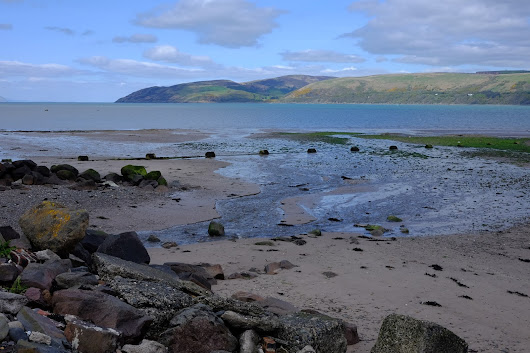In this blog post I hope to give you a better feel for what it is really like to "wander around the Wig". We'll be taking a virtual tour around the Wig, following the route I normally take. This post will heavily feature photographs, showing what the landscape and habitats around the Wig are like. The photos will show the Wig at all times of the year and I'll highlight what species you might look out for at each area.
 |
| Sunrise over the Wig, from my house. |
I generally head for the Wig car park first, from here you have great views over all of Wig Bay and further out onto Loch Ryan. Looking out to the right you can see Marian Jetty, while the Scar is to the left. The car park is a great place to scan for seabirds: cormorants and shags, auks, divers, grebes and sea-ducks.
At low tide, a stretch of seaweed, sand, shingle and mud is exposed, proving popular with feeding waders. In the winter, species such as wigeon, brent geese and shelduck also can be found feeding on this area.
From the car park, a track follows the beach up to the Scar Hut (an observation post from World War II). Along here you can not only keep an eye on the shore to your right but also view the fields to your left. These fields may hold a range of species throughout the year, from swans and geese to waders, linnets and twite.
We have given the different fields names to help us record birds in specific areas: towards Kirkcolm are the swan fields, next the Wig track are the twite fields and the field that frequently floods to form a soggy pool in winter is the flash field.
 |
| The winter 'flash' field... being enjoyed by brent geese and oystercatchers. |
Once you get to the Scar Hut it is another great place to stop for a look. From here you can see out over the Scar and also towards the mouth of Loch Ryan and Ailsa Craig. Eiders can be seen hauled out on the Scar at any time of year and wader flocks and gull flocks sometimes gather there to roost. In the summer, terns may be seen bouncing by overhead and gannets soar by on their way to Ailsa Craig. Skylarks, ringed plovers and oystercatchers all breed here, so please don't walk out onto this area.
 |
| A flock of knot come in to land on the Scar, where brent geese, cormorants, shags, wigeon and a common gull are already resting. |
 |
| Ailsa Craig, with Arran in the background. |
From the Scar Hut, you may head straight back to the car park, however, there is a circular route around the Wig. As you head north along the path, in summer you can hear the sounds of whitethroats, stonechats, blackbirds and many other species singing away from the vegetation.
 |
| At the Scar Hut area, looking towards Corsewall Estate and the mouth of Loch Ryan. The sea radish along here looks gorgeous in the summer. |
As you continue along the path, it meanders away from the shore slightly, opening out into a more grassy area. To the left is another field that floods in the winter: we've dubbed it the pool field (yes, I know, we're not a very inventive bunch!), which may be home to curlews, teal or a heron.
 |
| The pool field with a dusting of snow. |
Just a little bit further along and Corsewall Burn meets Loch Ryan. We have given this area two names: Fisher's Lane outlet (the side meeting the loch) and Fisher's Lane pool (on the other side of the path). Often bereft of birdlife, it is nevertheless always a good idea to stop and look because we have had records of dipper, kingfisher, snipe, common sandpiper, water rail and more!
 |
| Fisher's Lane pool. |
Now we are coming onto the final stretch of our tour. There is a path that you can take that heads past the marsh (see our separate blog post on the marsh: A Smorgasbord of Surprise: The Marshes) and leads into a circular route through the woods of Corsewall Estate. However, I most often head back through a shorter stretch of woods leading onto Fisher's Lane and the bottom of Kirkcolm village by the school. Keep your eyes and ears peeled for roving tit flocks, treecreepers and goldcrests flitting in the treetops ahead. Once out of the woods, it's a short walk back along Fisher's Lane and a left turn to head back to the Wig car park.
That concludes our virtual tour of the Wig - I hope that you enjoyed it! At the very least, it's something a little different from our regular posts.
[Unless otherwise stated, all photographs are taken by and belong to Stephen Grover - please ask for permission if you wish to use them.]







No comments:
Post a Comment